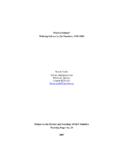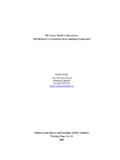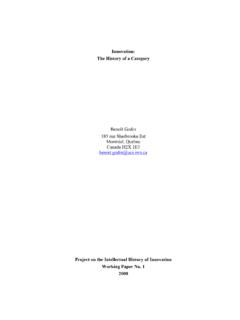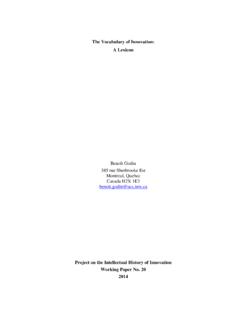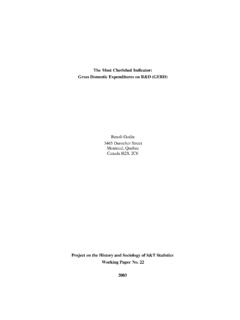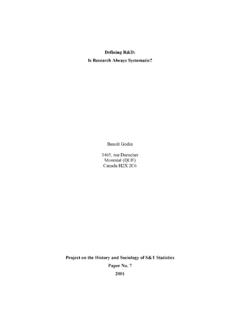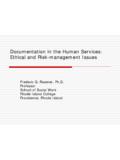Transcription of Measuring the Impacts of Science : Beyond the …
1 Measuring the Impacts of Science : Beyond the economic Dimension 1 Beno t Godin and Christian Dor Introduction For over fifty years, governments have funded research and development (R&D) because of the impact (or outcome) it has or we think it has on society. Although scientific policy has for a time been driven by the policy for Science philosophy or ideology, there has never been any doubt in the minds of policy-makers that the ultimate aim for funding Science and technology was socio- economic goals such as national security, economic development, welfare and the environment. The socio- economic goals of public funding were so pronounced that, from the beginning, academic researchers and statistical offices Measuring Science and technology discussed how to measure output and outcome of scientific research and developed several indicators to this end.
2 Now, one has historical series of output indicators on patents, technological balance of payments and high-technology trade, for example. We also have multiple studies linking Science and technology to productivity and economic growth. OECD countries have also adopted a standard classification to measure and break down public R&D expenditures by socio- economic objectives. Despite these efforts, however, we still know very little about the impact of Science . First, most studies and indicators are concerned with economic impact . While economic impact is important and, above all, non negligible, it represents only a small fraction of the whole which extends to the social, organizational, and cultural spheres of society.
3 As S. Cozzens argued recently: The majority of [the measurement effort] has studied the process of innovation and not its outcomes. Traditional innovation studies still focus narrowly on making new things in new ways, rather than on whether the new things are necessary or desirable, let alone their consequences for jobs and wages (Cozzens, 2002: 101). Second, the few discussions and measurements that go Beyond the economic dimension concentrate on indirect rather than ultimate impact . We still have, forty years after the first demands for impact indicators, to rely on case studies to quantify, very imperfectly, dimensions other than the economic one.
4 This paper provides a framework to assess the contribution of Science to society. It is divided into three parts. The first reviews the indicators of the impact of Science available 1 This research benefited from funding from the Quebec Department of Research, Science and Technology (MRST), and from the three Quebec funding councils. 2in the literature and explains why economic indicators dominate the field. It also discusses some recent exercises that try to extend the discussions and measurements of impact to more intangible dimensions , and shows that these interesting results nevertheless fail to properly address the issue.
5 The second part develops a typology of impact covering eleven dimensions . Beyond the economic dimension, the typology concentrates on more intangible ones. The third part discusses the challenges confronting social scientists and statisticians interested in Measuring the impact of Science . Measuring the Quantifiable In the literature, most if not all measured impact of Science concentrates on the economic dimension. In the 1950 s, economists began integrating Science and technology into their models, and focused on the impact R-D had on economic growth and productivity. Solow s (1957) approach has been the dominant methodology for linking R-D to productivity.
6 He was the first to formalize accounting growth (decomposing GDP into capital and labour), and equated the residual in his equation with Science and technology although he included more than just Science and technology. Denison (1962; 1967) and Jorgenson and Grilliches (1958), among others, later improved on Solow s approach. Following Solow s initial work, many cost/benefit analyses were conducted and econometric models developed that tried to measure what the economy owed to Science (Table 1). Many studies concentrated on estimating the rate of return to investment in R-D. They took two forms: return to publicly funded R&D and return to privately funded R-D.
7 Since then, studies on the economic impact of Science have focused on two topics: productivity and spillovers (from university and government funding of research, and across sectors and industries). One topic that also deserved early attention was the impact of Science on international trade. As early as the 1960 s, economists began integrating Science into models on international trade (Posner, 1961; Vernon, 1970). Using R&D as a factor to explain international trade patterns, the authors discussed why some countries led in terms of trade while others lagged. The literature on the non- economic impact of Science is far less abundant.
8 impact on Science itself is probably the most studied in the literature. Citation count has been used for more than 30 years to measure the impact of scientific publication on other researchers. The contribution of the Science Policy Research Unit (SPRU) in Sussex, England and the Center for Science and Technology Studies (CWTS) in Leiden, Netherlands has been especially important. The impact on technological innovation has also received a lot attention from researchers (Gibbons and Johnston, 1974; Mansfield, 1991; 1998; Rosenberg and Nelson, 1996). For instance, several authors, among them E. Mansfield, have illustrated the importance of academic research to the advance of industrial innovation.
9 They argued that a large proportion of firms would not have developed products and processes in the absence of academic research. 3 Table 1 Sample of Studies on the economic Dimension of Science Studies of other types of impact are rather scarce. Certainly, one can find some empirical studies on the impact of new technologies (computers) on jobs and work division (for examples, see OECD, 1996), or measures of the return on investment in health research on the burden of disease incidence, prevalence, hospital days, mortality, years of life lost (Comroe and Dripps, 1976; Hanney et al., 1999; Gross and al., 1999; Grant, 1999).
10 One can also find several evaluation of specific public programs that deal with socioeconomic Impacts , for example at the European Commission level. But most of the literature is concerned with the definition of the right approach to be used in the evaluation of impact or simply with the description of the available methods to do so (for recent examples, see: Garrett-Jones, 2000; Meulen van der meulen and Rip, 2000; Roessner, 2000; Caulil et al., 1996; Kostoff, 1994). Many authors acknowledged the difficulty of Measuring impact , first due to the fact that it is indirect rather than direct, and second because it is diffused in space and time.
